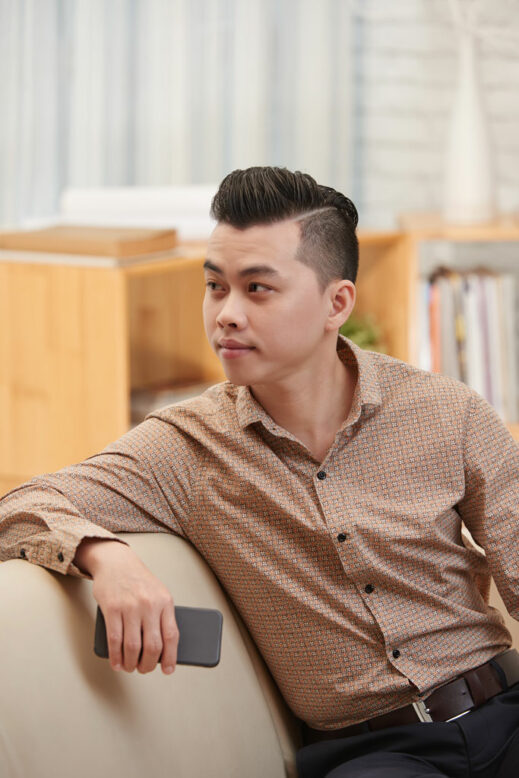A few months ago, we discussed the various ways to translate the word ‘beautiful’ in Italian, but what about ‘handsome’? In today’s article, we’re going to take a look at five of the most commonly used terms used to describe a good-looking man in Italian. Let us know if you can think of any others in the comment section below!

Learn with our video
1. Bello
Bello should be your go-to word for handsome in Italian, although it can translate in many other ways including beautiful, nice, wonderful, fine and so on.
Maria pensa che quell’uomo sia molto bello.
Maria thinks that man is very handsome.
Bello is one of those adjectives that can come before or after the noun. When it precedes most masculine singular nouns, bello is abbreviated to bel. However, it becomes bell’ in front of vowels. For example:
- un bell’uomo = a handsome man
- un bel ragazzo = a handsome guy / young man
- un bel ragazzino = a handsome young man / teenager
- un bel bambino = a handsome boy
- un bel signore = a handsome gentleman
- un bel tizio = a handsome dude
When it follows the noun, its form does not change.
- un uomo bello = a handsome man
- un ragazzo bello = a handsome guy / young man
- un ragazzino bello = a handsome young man / teenager
- un bambino bello = a handsome boy
- un signore bello = a handsome gentleman
- un tizio bello = a handsome dude

Note: Ciao bello! is a very common greeting in Italy. Although it literally translates as Hi handsome! or Bye handsome! there is nothing suggestive about this phrase whatsoever. In fact, both men and women use it with their male friends all the time. The closest equivalents in English would be Hey man! / Hey mate!
Here are a few other terms you might use if you’re feeling romantic:
- Buongiorno, bello mio! = Good morning, (my) handsome!
- Buonanotte, bello mio! = Good night, (my) handsome!
- Arrivederci, bello mio! = Goodnight, (my) handsome!
- Sogni d’oro, bello mio! = Sweet dreams, (my) handsome!
- Ti amo, bello mio! = I love you, (my) handsome!
- Il mio bell’uomo = My handsome man
2. Bellissimo
Bellissimo is the absolute superlative of bello, with the suffix -issimo meaning ‘very’ or ‘extremely’. Italians will use this form to add extra emphasis if they feel someone is exceptionally handsome.
Like bello, bellissimo can come before or after the noun it describes. However, its location does not cause a change in form.
- un bellissimo uomo / uomo bellissimo = a handsome man
- un bellissimo ragazzo / ragazzo bellissimo = a handsome guy / young man
- un bellissimo ragazzino / ragazzino bellissimo = a handsome young man / teenager
- un bellissimo bambino / bambino bellissimo = a handsome boy
- un bellissimo signore / signore bellissimo = a handsome gentleman
- un bellissimo tizio / tizio bellissimo = a handsome dude
Quel ragazzo è bellissimo. Potrebbe fare il modello.
That boy is very handsome. He could be a model.

Another way of being emphatic is to add the adverbs molto (very), proprio (really), or così (so) in front of bello.
Come fai ad essere così bello? Non è giusto!
How can you be so handsome? It’s not fair!
3. Attraente
Attraente is the word for attractive in Italian. It refers, not only to a person’s physical appearance, but also their charming and seductive manners.
Io mi chiedo: cosa rende un uomo attraente agli occhi delle donne?
I wonder: what makes a man attractive to women?

4. Fusto
Fusto actually means trunk (of the human body) but it is sometimes used in a humorous way to describe a good-looking young man with a tall, robust and athletic build.
Pietro è un vero fusto e piace molto alle donne.
Pietro is a total hunk and women really like him.

5. Fico / Figo
Fico is actually a slang word in Italian that means hot or cool guy. And yes, before you ask, fico also means fig in Italian! Depending on the region, one might say figo instead of fico. For example, my husband, who comes from Turin in the north, only ever uses figo.
Like many adjectives, fico / figo can be used as a noun (e.g. un figo = a hot guy, a cool dude).
Il ragazzo di Marta è un gran figo.
Marta’s boyfriend is so hot.

This article is also available in video format on our YouTube channel. The audio version can be found on Podbean, Google Podcast, Apple Podcast and Spotify.
Heather Broster is a graduate with honours in linguistics from the University of Western Ontario. She is an aspiring polyglot, proficient in English and Italian, as well as Japanese, Welsh, and French to varying degrees of fluency. Originally from Toronto, Heather has resided in various countries, notably Italy for a period of six years. Her primary focus lies in the fields of language acquisition, education, and bilingual instruction.


